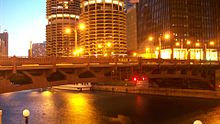Wabash Avenue Bridge
Wabash Avenue Bridge | |
|---|---|
 Wabash Avenue Bridge at night | |
| Coordinates | 41°53′17″N 87°37′37″W / 41.887924°N 87.626839°WCoordinates: 41°53′17″N 87°37′37″W / 41.887924°N 87.626839°W |
| Carries | Automobiles Pedestrians |
| Crosses | Chicago River |
| Locale | Chicago, Cook County, Illinois |
| Official name | Irv Kupcinet Bridge |
| Other name(s) | Wabash Avenue Bridge |
| Maintained by | Chicago Department of Transportation |
| ID number | 000016605226647 |
| Characteristics | |
| Design | Double-leaf bascule bridge |
| Total length | 345 feet (105 m) |
| Width | 90 feet (27 m) |
| Longest span | 232 feet (71 m) |
| No. of spans | 3 |
| Clearance below | 22 feet (7 m) |
| History | |
| Designer | Thomas Pihlfeldt |
| Opened | 1930 |
| Statistics | |
| Daily traffic | 5,800[1] |
| Location | |
 | |
The Wabash Avenue Bridge (officially, Irv Kupcinet Bridge) over the Chicago River was built in 1930. Standing west of the Michigan Avenue Bridge and east of Marina City, the bascule bridge connects the Near North Side with "The Loop" area.
The single-deck, double-leaf bascule bridge was designed by Thomas Pihlfeldt and built by the Ketler and Elliot Company.[2] The American Institute of Steel Construction awarded it the "Most Beautiful" bridge in 1930.[2]
The control houses for controlling bridge operations are on the northwest and southwest corners of the bridge. The control houses are identical in design. In 1961 the control houses were upgraded to allow single man operation. Electrical modernization also accompanied this upgrade. While the northern control house is no longer in use, it still stands.[2]
See also[]
References[]

- ^ "NBI Structure Number: 000016605226647". Retrieved 2009-05-18.
- ^ a b c National Park Service. "Historic American Engineering Record". Retrieved 2009-05-18.
External links[]
| Wikimedia Commons has media related to Wabash Avenue Bridge. |
- Historic American Engineering Record (HAER) No. IL-48, "Bascule Bridge, Wabash Avenue, Spanning Chicago River at North Wabash Avenue, Chicago, Cook County, IL"
- Google Earth Model
- 1930 establishments in Illinois
- Bascule bridges in the United States
- Bridges completed in 1930
- Bridges in Chicago
- Historic American Engineering Record in Chicago
- Road bridges in Illinois
- Steel bridges in the United States
